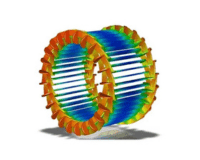PRODUCT OVERVIEW
Ansys Maxwell is an Electromagnetic field simulation solver for electric machines, transformers, wireless charging, permanent magnet latches, actuators and other electric mechanical devices. It solves static, frequency-domain and time-varying magnetic and electric fields. Maxwell also offers specialized design interfaces for electric machines and power converters.
Product Features

New Time Domain Solver
With Maxwell, you can precisely characterize the nonlinear, transient motion of electromechanical components and their effects on the drive circuit and control system design. By leveraging Maxwell’s advanced electromagnetic field solvers and seamlessly linking them to the integrated circuit and systems simulation technology.

PExprt
Power Electronics Expert (PExprt) is a magnetic design and optimization tool for ferrite transformers and inductors including, multi-winding transformers, coupled inductors, and flyback components. PExprt’s template-based interface for transformers and inductors can automatically create a design from voltage waveform or converter inputs. The auto-design process considers all combinations of core shapes, sizes, materials.

Simplorer
A multi-domain power electronics simulator for electrical, magnetic, mechanical, fluid, and thermal systems that seamlessly integrates three fundamental component libraries: circuits, block diagrams, and state machines. Simplorer provides an integrated analysis thanks to its connection with EM (Maxwell, PExprt, RMxprt, Q3D, HFSS) and thermal tools (Ansys CFD, Ansys Icepak).

RMxprt
In addition to providing classical motor performance calculations, RMxprt automatically generates geometry, motion and mechanical setup, material properties, core loss, winding and source setup for detailed finite element analysis in Maxwell.

Specialized Design Interfaces
Electric machines and power converters require significantly different design criteria and simulation, which is why Maxwell provides specialized interfaces for each.

Advanced Magnetic Modeling
Perform advanced simulation calculations such as core loss calculations, vector hysteresis, four-quadrant simulation for permanent magnets, magnetostriction and magnetoelastic analysis, Litz Wire Loss and manufacturing effects on loss computation.

Automatic, Adaptive Meshing
A key benefit of Maxwell is its automatic adaptive meshing techniques, which require you to specify only the geometry, material properties and the desired output to obtain an accurate solution. Maxwell’s meshing process uses a highly robust volumetric meshing technique and includes a multithreading capability

Multiphysics Coupling Workflow
Maxwell’s electromagnetic field solvers are linked through Ansys Workbench to easily set up and analyze complex coupled-physics behaviors such as deformed mesh feedback structures, stress and strain feedback on magnetic properties, EM fluids and acoustics.
MODULES
Low-Frequency Electromagnetic Simulation
With Maxwell, you can precisely characterize the nonlinear, transient motion of electromechanical components and their effects on the drive circuit and control system design. By leveraging Maxwell’s advanced electromagnetic field solvers and seamlessly linking them to the integrated circuit and systems simulation technology, you can understand the performance of electromechanical systems long before building a prototype in hardware.
Slice-only Technology
Slice-only technology enables a cyclic repeatability simulation technique for electric motor applications. The analysis has been improved by efficiently solving just a slice of the motor, employing non-planar boundary conditions, using symmetric mesh and replicating results to the full model. To learn more about how “slice-only” technology helps simulate complex electric motors

Increase machine efficiency and reduce time-to-market with Ansys Maxwell simulation
Customizable modeling, adaptive meshing, and high-performance computing enable designers to solve electromechanical power systems. Generate nonlinear circuits and state-space models for system simulation, ensuring fidelity in SIL and HIL systems. Ansys simulation predicts real-world performance, ensuring product integrity and driving innovation.
Product Specs
Reduced-Order Modeling
Co-sim Transient Performance
2D and 3D EM Solvers
Slice-Only Solving
Automatic Adaptive Meshing
Component to System
What’s New

Continuum Air
Improve simulation quality with the new Continuum Air solution technique for electric machines using an improved formulation for rotational motion. Users can now more easily obtain increased accuracy for solutions, such as cogging torque, and variable time steps and rotor speeds.

New Power Electronics Solver
The eddy current A-Phi solver solution solves challenging applications in power magnetics and busbars. This solver can also be used to calculate AC loss, proximity effect, current flow, and force in the design of consumer electronics devices and in the energy and industrial equipment sectors.

DC & AC Fields Combination
Enhance your understanding of AC and DC bias behavior in wireless charging and DC current bias applications. The improved workflow now incorporates a visualization of the overlayed AC and DC fields. This capability is especially important in consumer electronics, energy, and industrial equipment sectors.
Applications

Electric Motors
Ansys electric motor design software progresses from concept design to detailed electromagnetics, thermal and mechanical analysis of electric motors.

Power Electronics
Power electronics systems are complex. Simulation provides the tools to efficiently solve high-level design challenges, improve performance and drive innovation.

Wireless Charging Simulation
Ansys wireless power transfer solutions incorporate magnetic, thermal, and electrical system performance for wireless chargers.

E-motor NVH and Active Sound Design for EV
Ansys solutions for acoustics provides a complete multiphysics workflow for e-motor noise, vibration and harshness (NVH).
FAQs
What is Ansys Maxwell?
Ansys Maxwell is an electromagnetic field solver for electric machines, transformers, wireless charging, permanent magnet latches, actuators, and other electromechanical devices. It solves static, frequency-domain and time-varying magnetic and electric fields. Maxwell also offers specialized design interfaces for electric machines and power converters.
How do I learn Ansys Maxwell?
You can learn about Ansys Maxwell in several different ways depending on whether you are an existing customer or a student or non-customer.
What other Ansys tools interface with Ansys Maxwell?
Ansys Maxwell interfaces with Ansys Motor-CAD, Ansys HFSS, Ansys Icepak, Ansys Mechanical, Ansys CFD, Ansys Motion, Ansys TwinBuider and Ansys optiSLang.
How to create a closed region in Ansys Maxwell?
This displays the Region dialog box. You can define the region padding as a percentage, relative position, or absolute position.
For the Padding data, select either Pad all directions similarly, Pad individual directions, or Transverse padding.
How do I download Ansys Maxwell?
To download Ansys Maxwell, you must be an Ansys customer and have access to the Customer Portal. Ansys Maxwell is included in the Electronics software bundle and is also included in the free Ansys Student bundle.
What are some of the leading applications for Ansys Maxwell?
Ansys Maxwell can be used in a variety of applications, including electric machines, transformers, wireless charging, permanent magnet latches, actuators, sensors, conveters, electromagnetic shielding, and other electromechanical devices.
How to assign matrix parameters in Ansys Maxwell?
To solve for a capacitance, inductance, impedance, or conductance matrix:
Click Maxwell 3D or Maxwell 2D, and then select Parameters>Assign>Matrix.
The Matrix dialog box appears.
Click the Setup tab.
Type a name for the matrix in the Name box.
To specify the sources to be included in the matrix, do one of the following:
For 3D Electrostatic, 2D and 3D Magnetostatic, 2D and 3D Eddy Current designs, select or clear the Include check box for any of the listed sources.
For Maxwell 2D designs, the return path for each source may be specified. By default, the return path is at infinity; however, any conductor with a source specified can act as the return path.
For 2D Electrostatic, 2D and 3D DC Conduction, and 2D and 3D AC Conduction, select or clear the Signal or Ground check box for any of the listed sources. Grounded terminals are treated as reference voltages with zero voltage values.
Excitations checked as Signal will be in the matrix (excited one at a time with 1V during the parameters extraction process). Those excitations checked as Ground will be kept at 0 V and will not be part of the matrix. Any excitations not checked will not be considered.
How do I import a CAD file into Ansys Maxwell?
To import a 3D CAD file:
Click Modeler>Import.
The Import File dialog box appears.
Select the file type you want from the Files of type drop-down menu.
Select any import options available for the selected file type.
Use the file browser to find the file you want to import.
Click Open. The file is imported into the active Modeler window.

